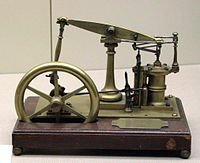
Photo from wikipedia
Abstract Pressure oscillation occurs during the steam jet condensation in water, notably in unstable flow pattern region. Consequently, pressure oscillation may risk the thermal system. In this work, we introduce… Click to show full abstract
Abstract Pressure oscillation occurs during the steam jet condensation in water, notably in unstable flow pattern region. Consequently, pressure oscillation may risk the thermal system. In this work, we introduce a method of reducing the pressure oscillation intensity by adding a small amount of air into steam in unstable flow pattern region. The effects of the air content on the unstable flow patterns and pressure oscillation characteristics were studied experimentally. Notably, the air layer showed a periodic accumulation-and-dispersion phenomenon around the steam–water interface. This phenomenon resulted in a periodic and dramatic fluctuation of the interface at a relatively low air mass fraction. When the air mass fraction increased to a critical value, the flow pattern became stable due to a sharp reduction in condensation rate. Accordingly, the pressure oscillation intensity increased and then dropped at the critical air mass fraction, showing a convex-shaped distribution. The air mass fraction should exceed the critical value if air is added into steam to reduce the pressure oscillation intensity. Otherwise, the air could lead to a much stronger pressure oscillation. A theoretical model for the critical air mass fraction was established and could predict the critical air mass fraction within a deviation of ±14%.
Journal Title: International Journal of Multiphase Flow
Year Published: 2019
Link to full text (if available)
Share on Social Media: Sign Up to like & get
recommendations!